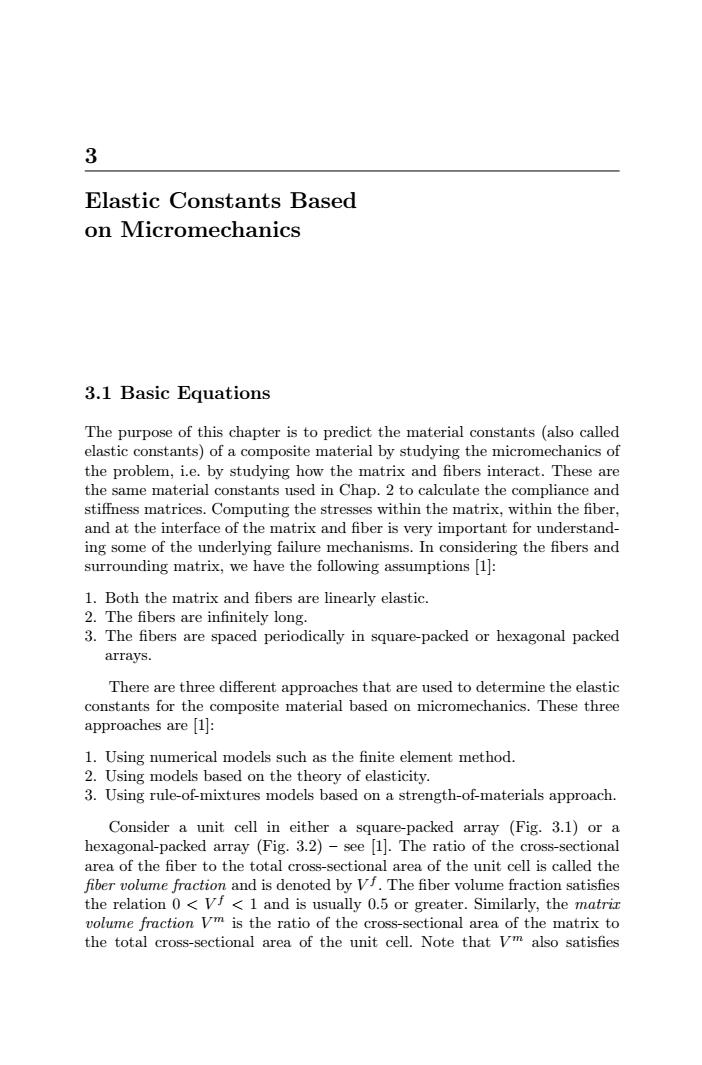正在加载图片...

3 Elastic Constants Based on Micromechanics 3.1 Basic Equations The purpose of this chapter is to predict the material constants(also called elastic constants)of a composite material by studying the micromechanics of the problem,i.e.by studying how the matrix and fibers interact.These are the same material constants used in Chap.2 to calculate the compliance and stiffness matrices.Computing the stresses within the matrix,within the fiber, and at the interface of the matrix and fiber is very important for understand- ing some of the underlying failure mechanisms.In considering the fibers and surrounding matrix,we have the following assumptions[1]: 1.Both the matrix and fibers are linearly elastic. 2.The fibers are infinitely long. 3.The fibers are spaced periodically in square-packed or hexagonal packed arrays. There are three different approaches that are used to determine the elastic constants for the composite material based on micromechanics.These three approaches are [1]: 1.Using numerical models such as the finite element method. 2.Using models based on the theory of elasticity. 3.Using rule-of-mixtures models based on a strength-of-materials approach. Consider a unit cell in either a square-packed array (Fig.3.1)or a hexagonal-packed array (Fig.3.2)-see [1].The ratio of the cross-sectional area of the fiber to the total cross-sectional area of the unit cell is called the fiber volume fraction and is denoted by Vf.The fiber volume fraction satisfies the relation 0<Vf<1 and is usually 0.5 or greater.Similarly,the matrir volume fraction Vm is the ratio of the cross-sectional area of the matrix to the total cross-sectional area of the unit cell.Note that Vm also satisfies3 Elastic Constants Based on Micromechanics 3.1 Basic Equations The purpose of this chapter is to predict the material constants (also called elastic constants) of a composite material by studying the micromechanics of the problem, i.e. by studying how the matrix and fibers interact. These are the same material constants used in Chap. 2 to calculate the compliance and stiffness matrices. Computing the stresses within the matrix, within the fiber, and at the interface of the matrix and fiber is very important for understanding some of the underlying failure mechanisms. In considering the fibers and surrounding matrix, we have the following assumptions [1]: 1. Both the matrix and fibers are linearly elastic. 2. The fibers are infinitely long. 3. The fibers are spaced periodically in square-packed or hexagonal packed arrays. There are three different approaches that are used to determine the elastic constants for the composite material based on micromechanics. These three approaches are [1]: 1. Using numerical models such as the finite element method. 2. Using models based on the theory of elasticity. 3. Using rule-of-mixtures models based on a strength-of-materials approach. Consider a unit cell in either a square-packed array (Fig. 3.1) or a hexagonal-packed array (Fig. 3.2) – see [1]. The ratio of the cross-sectional area of the fiber to the total cross-sectional area of the unit cell is called the fiber volume fraction and is denoted by V f . The fiber volume fraction satisfies the relation 0 < V f < 1 and is usually 0.5 or greater. Similarly, the matrix volume fraction V m is the ratio of the cross-sectional area of the matrix to the total cross-sectional area of the unit cell. Note that V m also satisfies